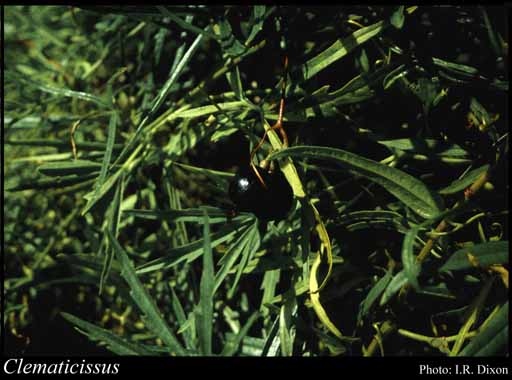- Reference
- Monogr.Phan. p422 (1887)
- Name Status
- Current

Scientific Description
Family Vitaceae.
Habit and leaf form. Lianas, or shrubs; deciduous. Climbing, or self supporting (then sprawling); the climbers tendril climbers (tendrils leaf-opposed, usually bifid). Stem growth conspicuously sympodial, or not conspicuously sympodial. Mesophytic, or xerophytic. Heterophyllous, or not heterophyllous. Leaves alternate; distichous, or spiral; petiolate; non-sheathing; gland-dotted; compound; ternate, or palmate. Leaflets (3–)5(–7). Leaf blades palmately veined, or pinnately veined; cross-venulate. Leaves with stipules. Stipules intrapetiolar; caducous, or persistent. Leaf blade margins entire to dentate. Leaves without a persistent basal meristem. Leaf anatomy. Hairs absent.
Reproductive type, pollination. Fertile flowers hermaphrodite. Unisexual flowers absent. Plants hermaphrodite.
Inflorescence and flower features. Flowers aggregated in ‘inflorescences’. Inflorescence many-flowered. Flowers in cymes. The terminal inflorescence unit cymose. Inflorescences leaf-opposed; in congested heads which terminate one or both branches of the tendril. Flowers bracteolate; minute; regular; 5 merous; cyclic; tetracyclic. Hypogynous disk present; intrastaminal; annular. Perianth with distinct calyx and corolla; 10; 2 -whorled; isomerous. Calyx 5; 1 -whorled; gamosepalous; shortly lobed; open in bud; regular; membranous; persistent. Corolla 5; 1 -whorled; polypetalous (although weakly cohering in bud); valvate; regular. Androecium 5. Androecial members free of the perianth (inserted at the base of the disk); all equal; free of one another; 1 -whorled. Androecium exclusively of fertile stamens. Stamens 5; isomerous with the perianth; alternisepalous. Anthers dehiscing via longitudinal slits; introrse; tetrasporangiate, or bisporangiate. Gynoecium 2 carpelled. The pistil 2 celled. Carpels reduced in number relative to the perianth. Gynoecium syncarpous; eu-syncarpous; superior. Ovary plurilocular; 2 locular. Gynoecium stylate. Styles 1; apical. Stigmas 1; capitate; dry type; non-papillate; Group II type. Placentation axile. Ovules 2 per locule; ascending; apotropous; collateral; non-arillate; anatropous.
Fruit and seed features. Fruit fleshy; indehiscent; a berry; 1–4 seeded. Seeds pyriform; endospermic. Endosperm ruminate; oily. Cotyledons 2. Embryo straight. Seedling. Germination phanerocotylar.
Physiology, biochemistry. Aluminium accumulation not found.
Geography, cytology, number of species. Native of Australia. Endemic to Australia. Australian states and territories: Western Australia. Eremaean Botanical Province.